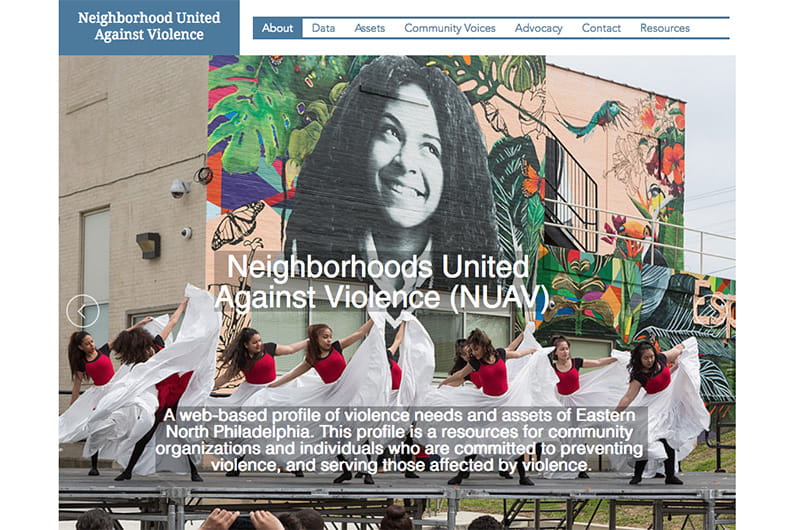Drexel, Congreso Partner to Map Neighborhood-Specific Violence Trends in Eastern North Philadelphia
 By Frank Otto
By Frank Otto

Hard numbers can be one of the most valuable assets for helping the community you love.
That’s why a partnership between Philadelphia non-profit Congreso and Drexel University’s Urban Health Collaborative have charted neighborhood-specific violence numbers in eastern North Philadelphia — the nexus of the city’s Latino population that includes neighborhoods like Kensington, Port Richmond and Juniata Park.
Tuesday, those numbers will be unveiled publicly on a new website, NUAVNow.org, an instant boost to the many neighborhood-based community organizations that need grants to survive because they’re operating with limited funds.
“The stakeholders in this community told us that violence was the biggest health issue facing their neighborhoods,” said Amy Carroll-Scott, PhD, an assistant professor in the Dornsife School of Public Health who is leading the Urban Health Collaborative’s efforts. “We wanted to provide numbers specific to their neighborhoods so that they had what they needed, at the ready, when they needed to write grants or advocate for services or policy changes.”
Standing for “Neighborhood United Against Violence,” NUAV presents data from a variety of different sources, all customized to describe violence and related factors in eastern North Philadelphia, displayed through mapping — formally called geographic information services.

“We know, anecdotally, that violence is happening in our community daily, but we’re busy providing services and supporting day-to-day operations, and don’t have the capacity to research the latest trends and numbers,” said Amy Eusebio, director of Family Wellness at Congreso, which seeks to boost the economic self-sufficiency and well-being of the city’s Latino community. “We thought it was important to have this partnership with Drexel because of that. It helps us and the other organizations that work with us.”
The neighborhoods are spread across multiple city police and public health districts, so numbers specific to this community are not easy to find. In the past, if someone happened to describe the violence or related assets in these specific neighborhoods for a project or a grant, “the data just sat on their computer” once their task was finished, according to Carroll-Scott.
Making a website was important because it allows for publicly accessible and up-to-the-minute updates on not just the violence numbers, but also information regarding the surrounding community and its residents. NUAVNow also includes a map-driven directory of violence prevention resources, including things like behavioral health programs and youth development services, that could help address violence. All of this can be updated continuously.
“In stakeholder meetings, they told us the last thing they needed was another resource directory that was outdated as soon as it was PDF-ed,” said Carroll-Scott. “We needed to create a website, and a sustainability plan that includes a manual for Congreso staff to run and update it.”

Funded by the Urban Health Collaborative, which is under the umbrella of the Dornsife School of Public Health, NUAVNow has been in development for two years. That process featured constant collaboration and feedback between Drexel, Congreso and community members.
“Amy [Carroll-Scott] really understands the idea of partnering with a community organization and leaning on us and our partners for insight and expertise,” Eusebio said. “I understand now why she’s involved in so many projects. She sincerely gets it.”
This project comes at an important time for the area.
“It’s a community experiencing a lot of change,” Carroll-Scott said. “These neighborhoods are in the center of the opioid epidemic at the same time that there is displacement and gentrification and a lot of evacuees coming in from Puerto Rico after Hurricane Maria.”
Grants for non-profit organizations are lifeblood, but securing one is a hyper-competitive process. Eusebio feels that the data and maps NUAVNow readily provides for neighborhoods will not just assist her organization, but also other partners in formal nonprofit organizations and grassroots community groups. Having community info at their fingertips will suddenly make them a lot more competitive when it comes to securing grants.
Moreover, the site’s population and asset data can help zero in on specific community needs.
“We hope it becomes a go-to source for anyone trying to figure out trends,” Eusebio said. “That could include someone asking, “Where should I start this after-school program or what block needs a Boy or Girl Scouts troop?”
With this information being more accessible, its value will spread across the eastern North Philadelphia community and hopefully result in positive impact.
“Our vision is that this is a live tool that anyone doing violence prevention work can access,” Eusebio said. “block captains, community members, and organizations included.”
In This Article
Drexel News is produced by
University Marketing and Communications.
